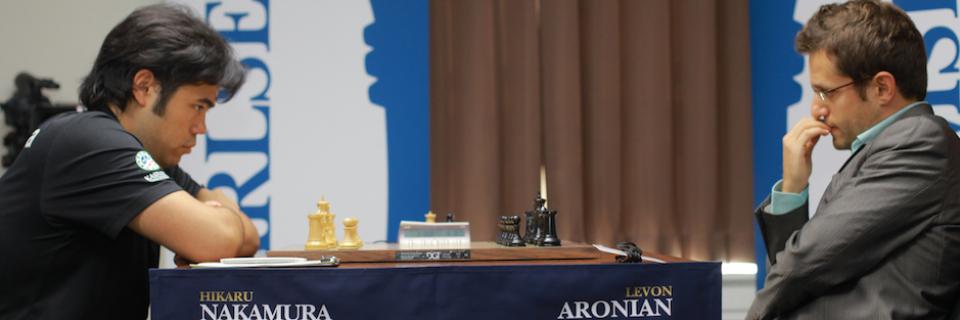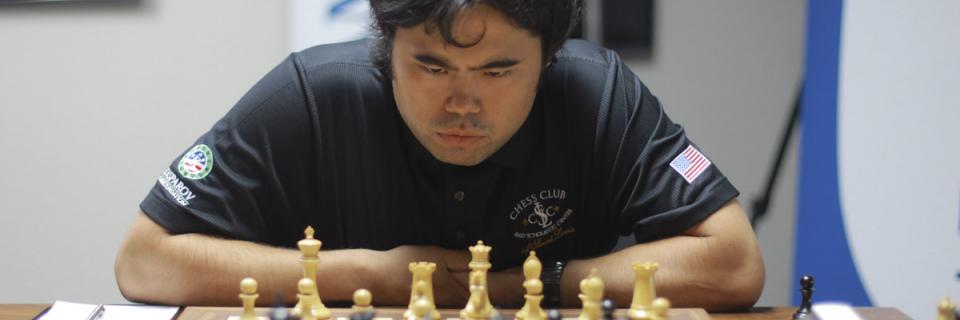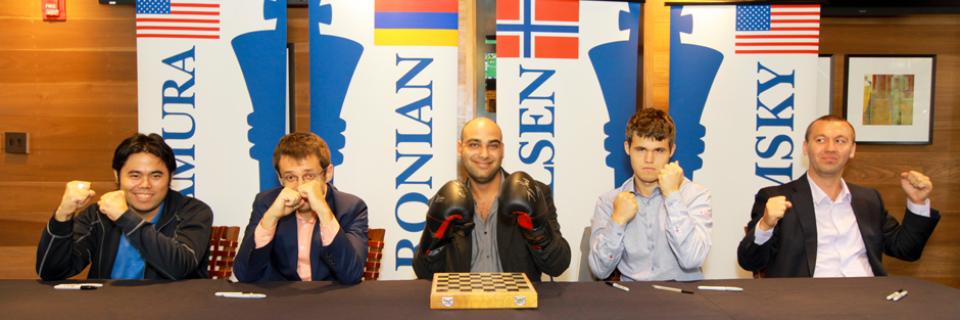2012 U.S. Championships News
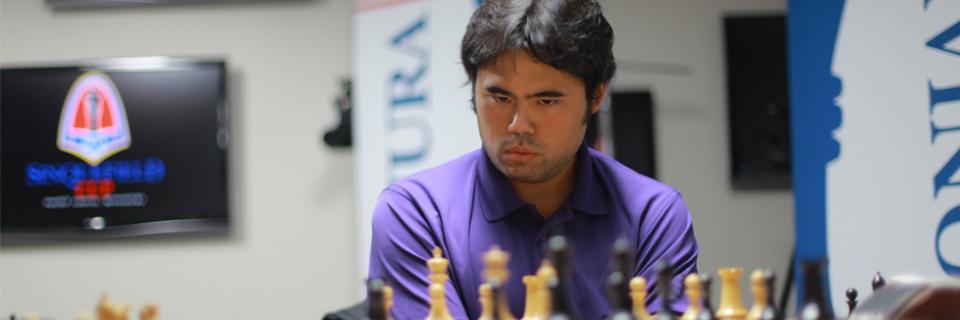
With his victory today, GM Hikaru Nakamura moved up to No. 5 in the world on the live rating list and is less than a point away from overtaking GM Alexander Grischuk for the No. 4 spot.
By Brian Jerauld
SAINT LOUIS (September 10, 2013) -- Hikaru Nakamura is done with the side dishes. Now bring on the main course.
Through the first two rounds of the inaugural Sinquefield Cup, the American No. 1 has already gotten fat from both number-twos in the quartet, first gobbling up a blunder by World No. 2 Levon Aronian on Monday, and then chewing through U.S. No. 2 Gata Kamsky on Tuesday to remain perfect through the tournament. Nakamura’s two points hold him in clear first in the six-game, double round-robin Sinquefield Cup, after World No. 1 Magnus Carlsen equalized early and convincingly in his 36th classical game against Aronian – but could not find a way to topple the Armenian king. The draw gave Aronian his first half point of the tournament and pulled Carlsen into second with 1.5/2. Kamsky still seeks his first tally.
Both number-ones – America’s Nakamura and the World’s Carlsen – will meet on Wednesday for the last game of the first cycle. Kamsky will command white for the first time in the tournament, against Aronian.

GM Gata Kamsky was out maneuvered in a tactical melee as he neared time control in round 2 against GM Hikaru Nakamura.
It would seem the United States’ top two players would have more of a history with each other, especially considering the world travelers have traded the title of U.S. Champion for the past five years, but much of 25-year-old Nakamura’s uprising came during 39-year-old Kamsky’s eight-year hiatus from the game. The two had met just eight times before the Sinquefield Cup, with six draws and a victory each; Tuesday proved to be a tiebreaker.
Despite his usual selections of 1. d4 or 1. Nf3 against Kamsky, Nakamura opened with 1. e4 for the second day in a row, to which Kamsky – on the attack after Monday’s loss to Carlsen – answered with the Kan variation of the Sicilian. Though both players would be nearly playing the increment by the 40th move time control, the game’s opening sped off at a furious pace for the first dozen moves, with early action.
Nakamura’s 9. Re1 looked innocuous, but his intentions became clear when Kamsky chased the white knight on c3, ushering 11. Nd5 – a square that black attacked twice, but with dangerous consequences upon capture. And still on his fast opening attack, Nakamura dropped 12. Qh5 with authority, immediately getting up from the board to let Kamsky think about the already dangerous position. But it was Nakamura who would give the game its first deep think, dropping nearly 30 minutes from his clock after Kamsky’s novelty response of 12. … Ne7.
Early signs of trouble turned into the real deal by 20. Qxf6, leaving Kamsky with a permanently weak king, a disharmonious army and a mounting white attack on the doorstep. The silver lining to his dreadful position, however, was Nakamura’s clock, which was 30 minutes lighter than Kamsky’s by the 22nd move.
Nakamura converted the first material advantage with 24. Bxh7, though it seemed to stifle his railroad momentum. At the cost of several tempi to pull his bishop back to safety, Kamsky found counterplay and eventually equalization with 28. … Qd6. Nakamura was under five minutes after 29. Rf1.
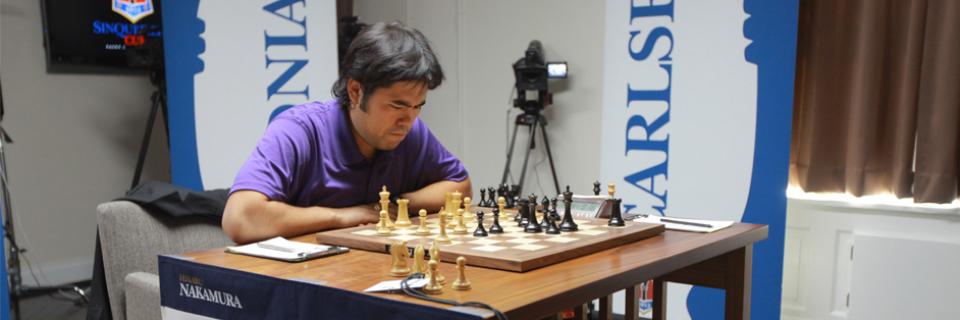
GM Hikaru Nakamura now stands alone atop the leaderboard with a perfect 2/2 score.
But 32. … Kb7 was a question mark for Kamsky, and Nakamura – a blitz world champion – was up to the task of keeping this new advantage. 35. Qc5 brought the white queen thrashing into the black camp, easily cracking open the position despite the threatening clock. The game was all-but over by time control.
“Probably around move 28-29, I was much more concerned about the time pressure mainly because there were many moves to consider, plans to consider for both sides; you can’t just make moves instantly,” Nakamura said. “When you’re playing at this level, any mistake is one too many. It’s quite nerve-racking, but I feel like I defended it quite well.”
Nakamura-Kamsky Annotations by GM Ben Finegold
Looking ahead to their Tuesday matchup after Aronian’s devastating blunder-loss on Monday, Carlsen proclaimed that he would “try to kick him while he’s down.” But nobody expected Carlsen to wear steel-toed boots.
The World’s best stomped all over the opening of the world’s next-best, first shocking Aronian’s 1. d4 with a Dutch defense that had spent nearly a decade on the Norwegian’s shelf, and then finding early equalization by move 11. … Ng5.
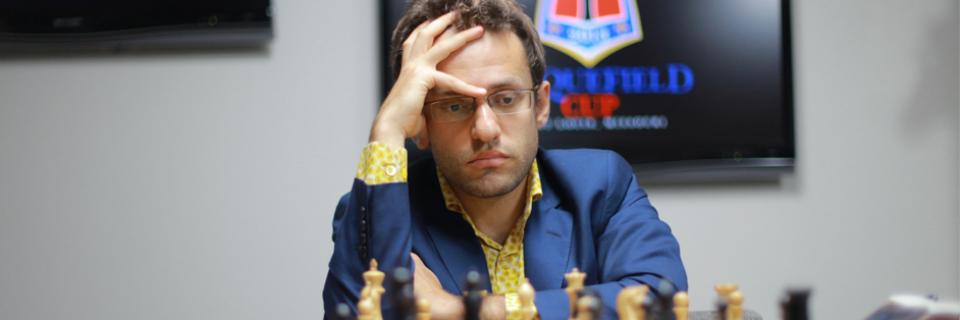
GM Levon Aronian fought an uphill battle all day and was fortunate to notch his first half point of the tourney against the World No. 1 Magnus Carlsen.
“I thought Aronian’s game against the Dutch hadn’t been particularly impressive,” Carlsen said. “I thought ‘Why not give it a try?’ especially as I was in a very good mood after my win yesterday. I got an excellent position, nothing to complain about there.”
Indeed, after an ugly looking 13. f4 was needed to chase the black queen, Aronian shifted fully into defensive mode after 15. … c5 locked Carlsen’s knight onto a brutal d4 outpost. Picking his poison, Aronian pushed 20. a4 to stop the b5 break, though it exposed weak squares on the white queenside. Smelling blood in the water, Carlsen was quick to redeploy his queen, stringing Qd8-Qa5-Qb4 and pushing his position to a near full-point advantage – seemingly with material on the way.
But Carlsen could not find a way to break the back of Aronian, who weathered the storm and slowly traded pieces to drown black’s attack. Despite spending most of the game in time trouble and without initiative, Aronian had all major pieces traded off the board by 37. Kxe1 and needed no use of the 40-move time bonus. Carlsen accepted his handshake before the 41st move.
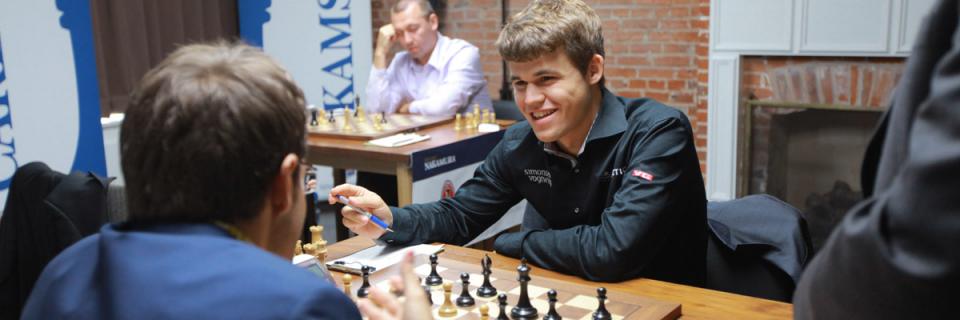
GM Magnus Carlsen will have the white pieces agaisnt tournament leader GM Hikaru Nakamura tomorrow.
“I was a bit too indecisive,” Carlsen said. “There were a lot of attractive options, and I didn’t choose the right one, evidently. For instance, I could have sacrificed my rook for a bishop at some point and gotten a fat pawn and some very active pieces. But I didn’t see anything really clear in that line, so I decided to postpone the critical moment a bit - and then it all just fizzled out. It was disappointing, but (Aronian) also deserves credit for defending such a grim position.
Aronian-Carlsen Annotations by GM Ian Rogers
Standings After Round 1
| No. | Name | Rating | Total |
|---|---|---|---|
| 1 | Hikaru Nakamura | 2772 | 2 |
| 2 | Magnus Carlsen | 2862 | 1.5 |
| 3 | Levon Aronian | 2813 | 0.5 |
| 4 | Gata Kamsky | 2741 | 0 |
Pairings for Round 3 - 09/11/2013
| No. | White | Rating | Result | Black | Rating |
|---|---|---|---|---|---|
| 1 | Carlsen, Magnus |
2862 | - | Nakamura, Hikaru |
2772 |
| 2 | Kamsky, Gata |
2741 |
- | Aronian, Levon |
2813 |
GM Hikaru Nakamura took advantage of a late blunder by World No. 2 GM Levon Aronian to defend his home turf in the first round of the 2013 Sinquefield Cup.
By Brian Jerauld
Games Annotated by GM Ronen Har-Zvi and GM Varuzhan Akobian
SAINT LOUIS, September 9, 2013 -- Welcome to the Sinquefield Cup. Please check your cell phones, your tablets – and all expectations – at the door.
Anyone visiting Saint Louis hoping to witness something they have never seen before just got their wish. For a moment, time stood still during Monday’s first round of the Sinquefield Cup, where Armenia’s Levon Aronian – the world No. 2 – offered up something nobody expected to see: A blatant blunder.
Round 1 of the strongest chess tournament in American history, showcasing four of the world’s top-20 players, is in the books with the first two games complete – and two full points already awarded. World No. 1 Magnus Carlsen put a slow squeeze on U.S. Champion Gata Kamsky, while the U.S. No. 1-by-rating Hikaru Nakamura was quick to attack a fatal misstep by Aronian.
GM Hikaru Nakamura took advantage of a rare misstep by World No. 2 Levon Aronian.
Despite the Ruy Lopez being one of Aronian’s main and productive lines, Nakamura showed no fear of familiarity by speeding quickly through the opening. Even as Aronian took the game into new territory with the first novelty of the tournament in 11. … Nfd7, Nakamura pushed 12. Nd4 with a nearly instant response, continuing with his own agenda. But Aronian’s response with an aggressive 12. … c5 sent Nakamura into his first deep think of the game, nearly 30 minutes before moving the seemingly natural 13. Nf5.
“I knew Nd7 was a novelty,” Nakamura said. “But after Nf5 and the correct response of Nf6, while I knew I could trade with Ne7, I had a feeling he was planning d5.”
Indeed, after Nakamura dropped Ne3 to bolster the pivotal square, Aronian challenged it just three moves later, eventually opening up the board to several avenues of attack for both sides. With the white queen open to attack, Aronian was able to equalize with 25. .. Nf4, ushering a trade of several minor pieces that had Nakamura admittedly ready to offer a draw.
But the move heard round the world was 30. … Qb5??, a severe blunder that ushered a trade-off of queens and Nakamura’s instant response of 32. Nd7 – winning an exchange and a slight smirk from the American. It left the world No. 2 visibly rattled, and the game was quickly liquidated into a full point for Nakamura.
“I prefer not to lose in such a way,” Aronian said. “But that’s something about the game of chess: It’s very humbling to lose after such a blunder.”
On the other board, Kamsky was tenacious with a bend-but-don’t-break attitude, but Carlsen’s grip with the white pieces turned into a slow strangulation of submission for the reigning U.S. Champion.
Perhaps bait to pull Kamsky into one of his most-familiar Slav lines, Carlsen showed little interest in finding an advantage in the opening and let the middle game decide fate. Standard lines continued until Kamsky offered an unprovoked 9. … Bxc3, providing Carlsen the lone bishop on the board.
The game’s pivotal move came with Kamsky’s 14. … h5 – the penultimate risk-reward that brought Kamsky his first taste of counterplay, but eventually served as his demise. Despite equal material, Carlsen’s white pieces proved incredibly active, owning the c-file with a rook battery and eventually placing two major pieces on Kamsky’s back rank – surrounding his desperately exposed king.

GM Gata Kamsky defended valiantly but was ultimately bested by GM Magnus Carlsen's unrelenting attack.
That said, Kamsky’s play in the weakened position was sharp and precise down the stretch, forcing Carlsen to be even more accurate. Claiming the full point was not a walk in the park for the World No. 1, several times being forced into finding the only correct move.
“I didn’t think h5 was a good move; it left his pawn a bit weak there,” Carlsen said. “But it did confuse me into making some stupid moves.”
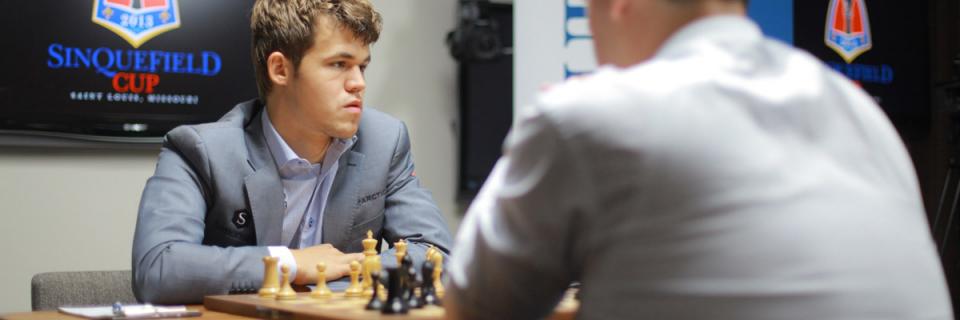
GM Magnus Carlsen had to play with extreme accuracy to knock off the reigning U.S. Champion, GM Gata Kamsky, in round 1 of the Sinquefield Cup.
Pairings for Round 2
| No. | White | Rating | Result | Black | Rating |
|---|---|---|---|---|---|
| 1 | Aronian, Levon | 2813 | - | Carlsen, Magnus | 2862 |
| 2 | Nakamura, Hikaru | 2772 | - | Kamsky, Gata | 2741 |
GM Hikaru Nakamura, GM Levon Aronian, Lindenwood University student George Krasnapolskiy GM Magnus Carlsen and GM Gata Kamsky pose during the autograph signing on September 8.
By Brian Jerauld
SAINT LOUIS – After a celebration weekend that began with the drawing of lots and finished with the drawing of crowds, the strongest chess tournament in American history is ready for its first move.
The Sinquefield Cup has arrived.
The top-2 players on earth – Norway’s Magnus Carlsen (FIDE No. 1, 2862) and Armenia’s Levon Aronian (FIDE No. 2, 2813) are set for battle with the top-2 players in the U.S., Hikaru Nakamura (FIDE No. 9, 2772) and Gata Kamsky (FIDE No. 16, 2741). Today at 1:00p.m., Carlsen will command white to attack Kamsky, while Nakamura takes the first move against Aronian.
The four superheros settled up on rules with International Arbiter Chris Bird during Saturday’s players meeting and drawing of lots. The Sinquefield Cup will follow a double round-robin format across six rounds, with players meeting each other twice – once as the white pieces and once as black. Time control will be 90 minutes for the first 40 moves, with an additional 30 minutes added after move 40 and 30-second increment for each move. No draw-by-agreement will be allowed before move 30. All rounds will begin at 1:00 p.m. local time, except for next Sunday’s final round, which will begin at 11:00 a.m, with a 6:00 p.m. playoff if necessary. Thursday will be a rest day.
A commemorative gift for the players, given during Saturday’s meeting, will simultaneously serve as a technological gift to the rest of the chess world. Bridging the connection between happy grandmasters and happy fans, the Sinquefield Cup will feature the first-ever DGT-enabled weighted sets. The electronic boards, which instantly cast games into digital form and fuel streaming commentary worldwide, have long drawn the ire of having sets that were too light – though any attempt to add metals as weight would disrupt the DGT sensors.
To tackle the perpetual problem, Rex Sinquefield, founder of the Chess Club and Scholastic Center of Saint Louis and sponsor of the Cup, put a phone call in to a literal rocket scientist: Frank Camaratta, a retired director of engineering for Pratt & Whitney aerospace manufacturer, and the founder of legendary chess set manufacturer House of Staunton.
“I have always wanted to make a nice-looking set that was fit for international play, and a nice weighted set for DGT boards was all part of the package,” Camaratta said. “After talking with Rex, I realized his vision was a lot like mine: This is a world-class tournament, and these professional chess players should be playing on the best equipment possible, to the level that these players deserve.”
Guided by Sinquefield’s style requests – ebony wood hand carved in the Imperial Collector design – Camaratta put some science into chess’ weight problem, figuring out the trick to DGT-allowable density and unlocking one of the hottest proprietary secrets in the game.
Also revealed at Saturday’s players meeting was the physical Sinquefield Cup, designed to be a recognizable championship trophy for years to come. The 24-inch representation of the King chess piece, a stylistic blend of Honduras Rosewood and brushed silver, will bear the names of winners throughout the years, residing on display in the tournament hall of the host Chess Club and Scholastic Center of Saint Louis. The winner, along with the $70,000 top prize, will receive a smaller 15-inch replica of the trophy.
"We wanted to create something timeless, classic and beautiful," said Chess Club Executive Director Tony Rich. "We hope this trophy will become the most sought-after chess hardware in the world."
With the rules, pieces and prizes out of the way, Sunday marked Signing Day in Saint Louis, where the players were available to the public for autographs and pictures. In true celebration of this first-in-a-lifetime event, more than 200 chess fans came from all corners of the nation to see Carlsen in his first tournament on American soil – and his last before November’s World Championship – or to shake hands with their favorite U.S. hopeful. By the signing session’s end, Aronian had developed his own cheering section, draped with several Armenian flags and applauding their national hero in the street.
From there, the four super stars were whisked away and brought in front of 60,000 new fans – welcomed during the halftime of the Saint Louis Rams game, where Carlsen took in his first-ever game of football.
That is: American football.
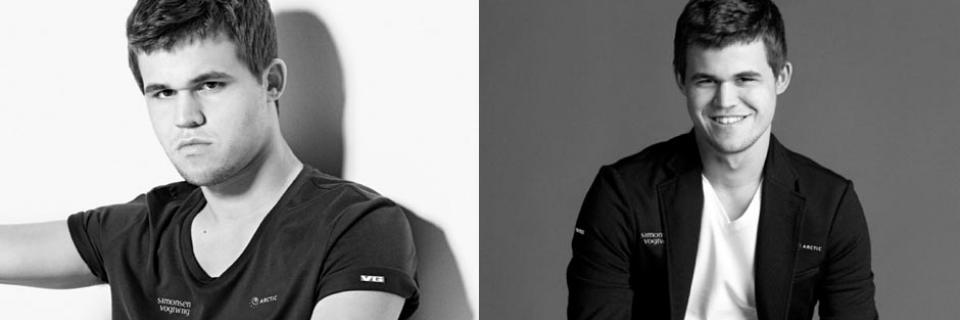
Magnus Carlsen has transcended chess superstardom to become a world icon. He will challenge Viswanathan Anand for the World Championship title in November.
By Brian Jerauld
Norwegian Grandmaster Magnus Carlsen is perhaps the most recognizable chess figure on the earth today. With a FIDE rating of 2862, he is the current No. 1 in the world, a rank he has held for more than two years. Only 22 years old, Carlsen has experienced one of the fastest ascents to the elite stratosphere of chess, the pinnacle of which may be realized this November when he challenges World Champion Viswanathan Anand for the world title.
Carlsen obtained his first IM norm in January 2003 and officially earned the title in August, still 12 years old. He earned his first GM norm by winning the Corus Chess Tournament in January 2004 and was eventually awarded the grandmaster title by that April, making him the second youngest in history at 13 years, 148 days.
In 2005, he became the youngest to appear in the Candidates Tournament, his first of three appearances in the event. In early 2008, Carlsen made his first move into the world’s top-5 – where he has remained since – and in November 2009, he broke the 2800 rating barrier, only the fifth ever and the youngest to do so. FIDE’s first rating list of 2010 named Carlsen the world’s No. 1, making him the youngest to ever hold the rank at 19 years and 32 days.
This year is shaping up to become one of Carlsen’s biggest – if only for the potential prize at the end. In January, FIDE showed Carlsen to have passed Garry Kasparov’s rating record of 2851, which had held for nearly 14 years. Carlsen set the new record with a peak of 2872 in February. He took first at the Tata Steel Chess Tournament for the third time, besting second-place Levon Aronian by 1.5 points, and took second in both the Norway Tournament and the Tal Memorial. Most importantly, Carlsen won the 2013 Candidate’s Tournament in March, earning the right to play for the World Champion title in Chennai, India, just over a month after his stay in Saint Louis.
Famous Washington Post columnist Lubomir Kavalek dubbed Carlsen the “Mozart of Chess” when he was just 14, a moniker that has since become entrenched by a recent CBS 60 Minutes interview. In 2012, Carlsen reportedly earned US $1.2 million, more than 60% of which came from sponsorship. This year, TIME Magazine named Carlsen one of the 100 Most Influential People in the World.
He is known for an endgame prowess amongst the greatest in history, as well as an unusually wide range of openings, which frustrates his opponents in their preparation against him. For his Sinquefield Cup matchups, the only player he does not have a career winning record against is Gata Kamsky, who has bested Carlsen 2-1 with six draws. Carlsen has never lost to Hikaru Nakamura, winning seven times and drawing 13. He holds the lengthy series between Aronian at 7-4 with 24 draws.

Hikaru Nakamura's playing style is brilliant and attacking, making him one of the most exciting players on the planet.
By Brian Jerauld
Grandmaster Hikaru Nakamura is the United States’ No. 1 chess player and the leading hopeful to bring America its first World Championship since Bobby Fischer. Born in Hirakata, Osaka Prefecture, Japan, the 25-year-old is now one of the world’s elite, currently ranked seventh on the planet with a FIDE rating of 2774.
A child prodigy in every sense of the word, Nakamura made a fast impact on United States chess by knocking down nearly every age record on his way to the top. Nakamura was at one time the youngest-ever American master in history (10 years, 79 days), the youngest American international master (13 years, 2 months) and eventually the youngest American grandmaster (15 years, 79 days) – breaking Fischer’s record by three months.
Nakamura has collected numerous titles and championships over the past decade-plus, first splashing onto the scene as the 2001 U.S. Junior Champion at 13 years old. He was on his way to becoming a prominent figure on the scene by 2004, shocking the world with a sweet sixteen appearance in the FIDE World Cup, and then grabbing his first of three U.S. Championships the following year.
He is a recipient of the prestigious Samford Chess Fellowship (2005), the 2007 National Open champion, and a three-time North American Open champion. He was an individual bronze medalist in the 2006 and 2008 World Olympiad, as well as the gold-medalist on the first board of the 2010 World Team Championship, where the United States placed second.
Nakamura’s first win amongst the super elite came in 2011 at the notorious Tata Steel Tournament in Wijk aan Zee, finishing clear first of defending champion Magnus Carlsen, current World Champion Viswanathan Anand, as well as Levon Aronian – a performance that Garry Kasparov touted as the best by an American since 1895. He is also a talented variant player, winning the Chess960 World Championship 2009 – a title he took from Levon Aronian – and one of the best blitz players in the world today.
Leading up to the Sinquefield Cup, Nakamura has continued his rise in strength in 2013. After winning the Biel Blitz Championship last year, he padded his blitz prowess as the Tal Memorial Blitz champion this past June – popping his FIDE blitz rating up to a career-best 2879. He surrendered defense of his 2012 U.S. Championship – a crown that has since been taken by Gata Kamsky – in lieu of the Norway Super Tournament, where he tied Carlsen for second place. Just before arriving in Saint Louis, Nakamura made a return to the sweet 16 in the 2013 FIDE World Cup.
Nakamura holds a losing record against Aronian, with three wins to five losses and seven draws; and he is tied with Kamsky with one win to one loss, with six draws. He remains winless against Carlsen, however, losing seven times in 20 games.

Grandmaster Levon Aronian of Armenia is currently ranked No. 2 in the world and holds a plus score agaisnt both of the U.S. competitors, Hikaru Nakamura and Gata Kamsky.
By Brian Jerauld
Grandmaster Levon Aronian is the pride of chess-strong Armenia, having been declared Sportsman of the Year twice, Honored Master of Sport in 2009 and, most recently, selected as the 2012 Person of the Year by a leading Armenian magazine. The 30-year-old is just the sixth player in history to cross the elite 2800 threshold, currently ranking No. 2 in the world at 2802. Aronian has remained in the world’s top three since November 2010 and has only twice slipped out of the top ten since July 2005.
Taught to move the pieces at 9 years old, Aronian was quick to appear on the world stage, winning the 1994 World Youth Chess Championship U12. In 2002, at 20, he won the Armenian Championship and later the World Junior Championship in India. But his mainstay in the world’s elite was marked in 2005, when he won the World Cup in Russia and cracked the world’s top 10 for the first time. Since then, Aronian has collected a staggering amount of elite titles.
He played the first board on three gold-medalist Armenian Chess Olympiad teams (2006, 2008 and 2012), also grabbing the individual gold in 2012. He has won the prestigious Tal Memorial and Corus/Tata Steel Chess Tournament three times each, and the FIDE Grand Prix twice. In 2009, he won the World Rapid Championship – a title that was taken from him the following year by Gata Kamsky – and in 2010 Aronian won the World Blitz Championship – a title that he took from defending champion Magnus Carlsen.
Aronian is also a talented chess variant player, becoming the Chess960 World Champion in 2006. He successfully defended the title to Viswanathan Anand in 2007, though lost it in 2009 to Hikaru Nakamura.
His play in 2013 leading up to the Sinquefield Cup has been representative of his elite status. A second place finish in the Tata Steel (behind Carlsen), a fourth place finish in the 2013 Candidates Tournament – his second appearance in the event – and a win at the Alekhine Memorial Tournament. Perhaps showing a bit of his human side, however, Aronian was surprisingly upset in the third round of the 2013 Chess World Cup in August, despite being the top seed.
In his career against Kamsky, Aronian is 5-1 with 2 draws; against Nakamura, Aronian is 5-3 with 7 draws. By far, his most familiar Sinquefield Cup opponent is Carlsen, with whom he has met for 35 classical games – Carlsen holds the series 7-4, with 24 draws.

